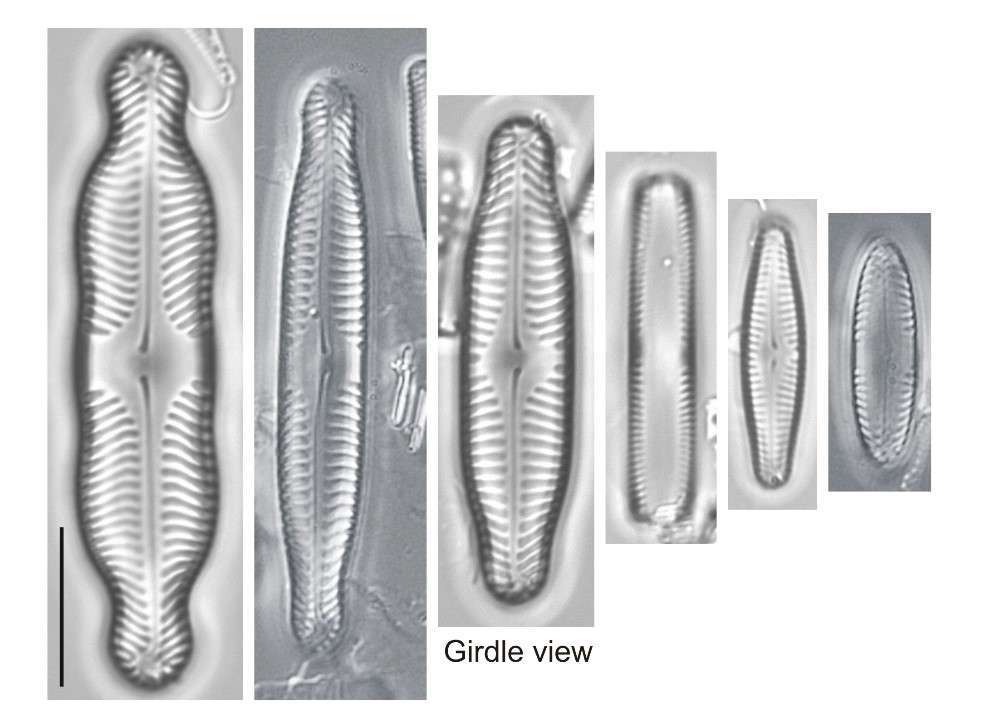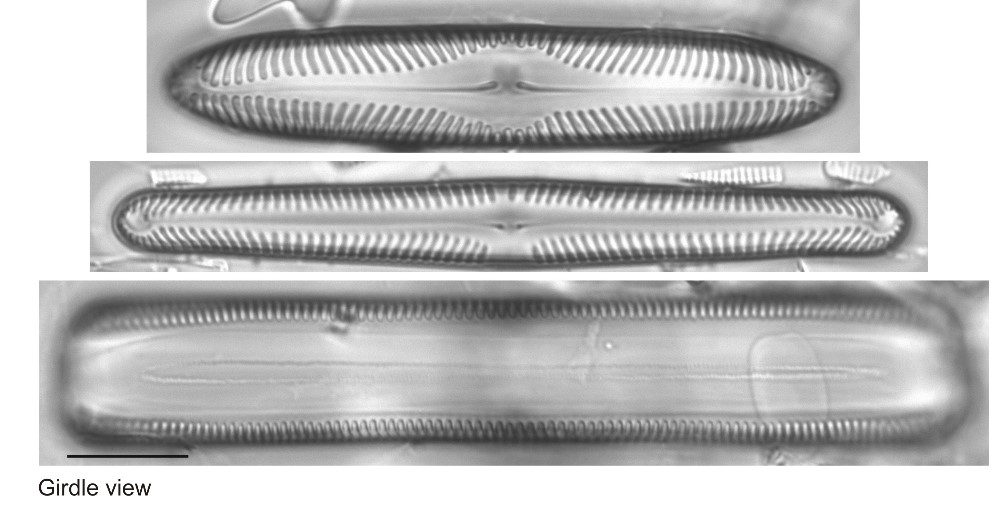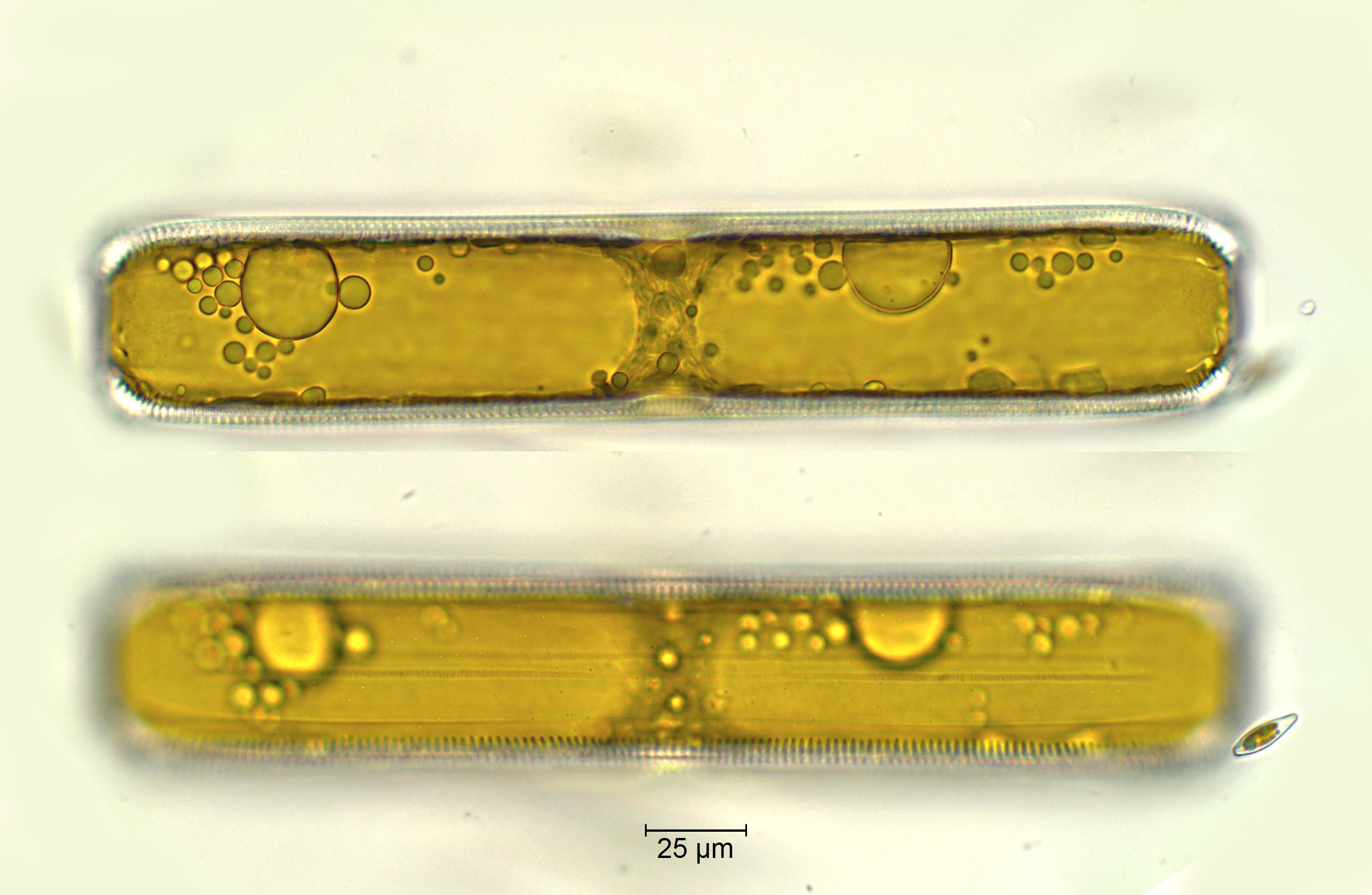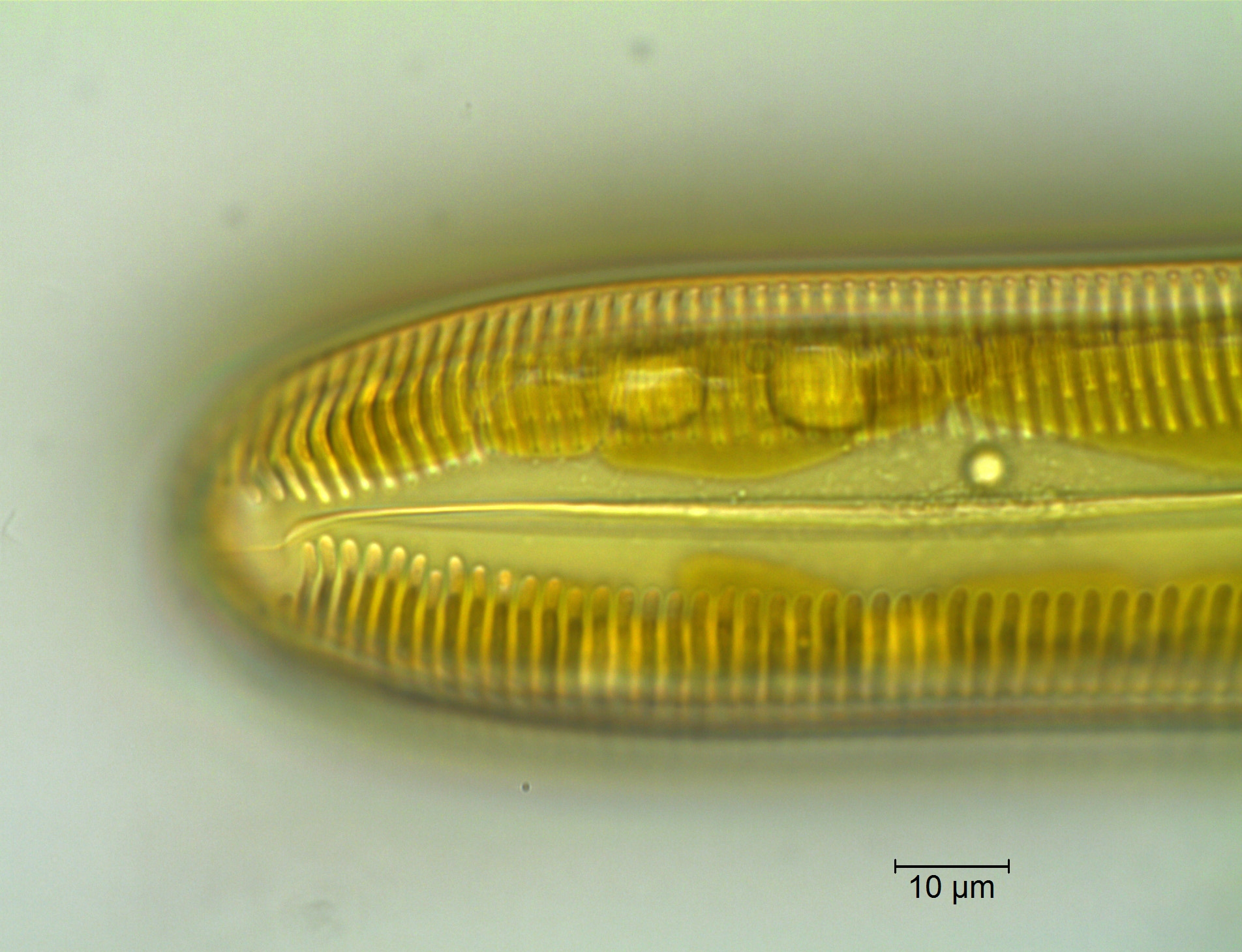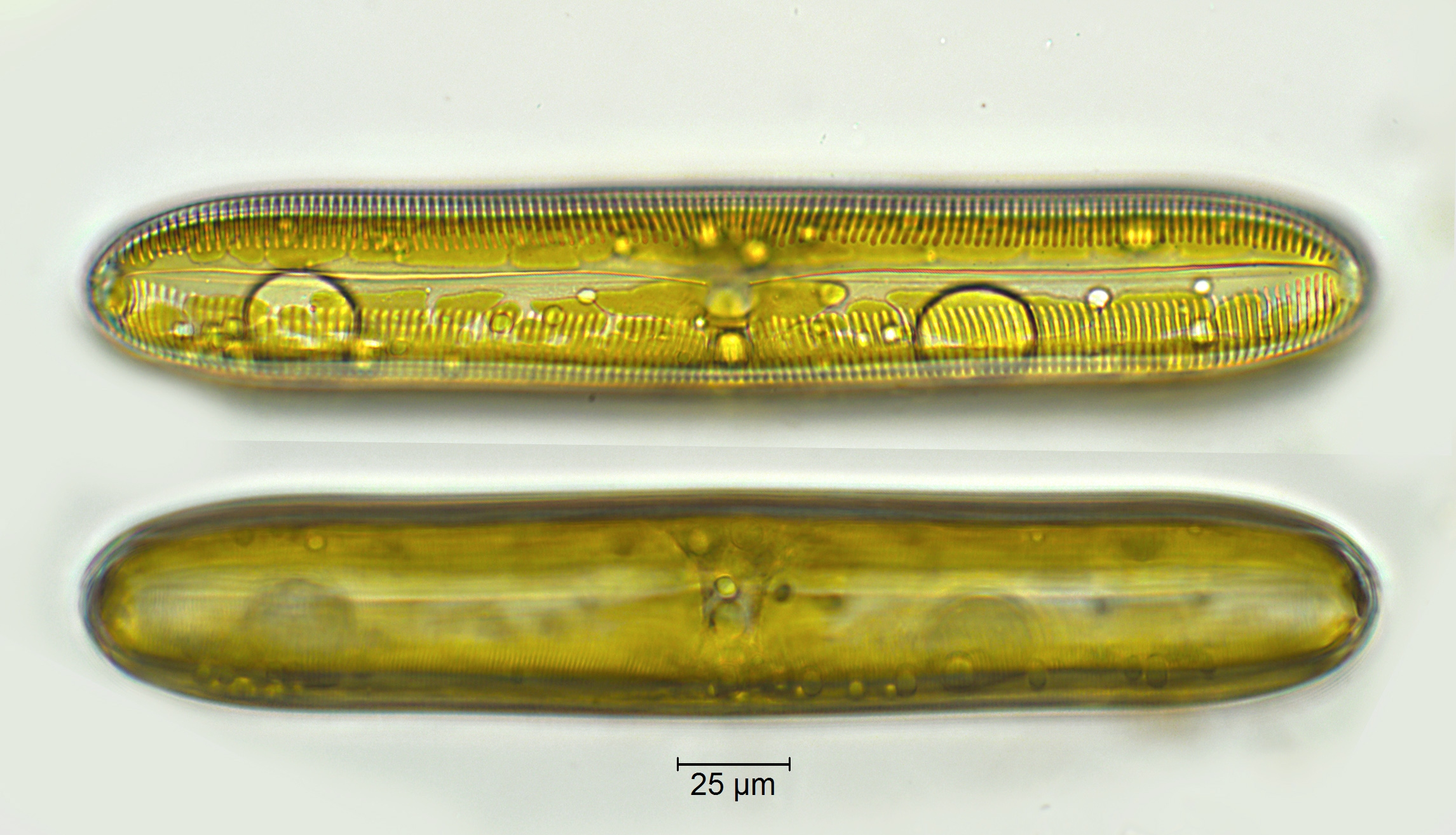Pinnularia C.G.Ehrenberg; 1843; 45
Key references
Krammer K. 2000. The genus Pinnularia. Lange-Bertalot H. (ed), Diatoms of Europe, Diatoms of the European Inland waters and comparable habitats, Vol.1, A.R.G. Gantner Verlag K.G., Ruggell. 703 pp
Metzeltin D., Lange-Bertalot H. 2007. Tropical diatoms of South America II. Special remarks on biogeography disjunction. Iconographia Diatomologica, Vol. 18., Annotated Diatom Micrographs. Diversity-Taxonomy-Biogeography. H. Lange-Bertalot (ed.), A.R.G. Gantner Verlag K.G. 877 pp
Van de Vijver B., Chattová B., Metzeltin D., Lebouvier M. 2012. The genus Pinnularia (Bacillariophyta) on Ile Amsterdam (TAAF, Southern Indian Ocean). Nova Hedwigia, Beiheft. 141: 201–236.
Morphology
Frustules isovalvar, isopolar, bilaterally symmetrical. Valve outline usually linear or linear-lanceolate, apices rounded, subrostrate or subcapitate; occasionally with undulate valve margins. Cells can lie in either valve or girdle view. The genus includes some of the largest freshwater diatoms.
Striae alveolate, comprising an elongated chamber that opens externally by many small areolae, and internally by one transversely elongate aperture (foramen).
Axial area narrow or wide, sometimes expanding towards the centre.
Central area variable, sometimes indistinguishable from the axial area, often expanded into a round or transversely elongate space, sometimes into a plain band (fascia) extending from margin to margin.
Raphe central, often with an undulate external fissure; central raphe endings often expanded, pore-like, deflected towards one side (the primary side); internal central endings hooked or, more often, hidden by an overgrowth of silica (from the primary side), making it appear from the interior that the raphe is continuous from pole to pole; terminal fissures deflected, often forming a question mark.
A few open girdle bands per theca, the first (most advalvar = valvocopula) with a single row of elongate pores.
In many species there are two plate-like chloroplasts lying along the sides of the girdle without obvious pyrenoids (though staining may reveal the presence of several to many rod-like pyrenoids). In these species, the chloroplast margins may be entire or variously lobed. Other species have a single H-shaped chloroplast with a narrow isthmus under one valve and then often with one or two pyrenoids, which may be invaginated.
Striae alveolate, comprising an elongated chamber that opens externally by many small areolae, and internally by one transversely elongate aperture (foramen).
Axial area narrow or wide, sometimes expanding towards the centre.
Central area variable, sometimes indistinguishable from the axial area, often expanded into a round or transversely elongate space, sometimes into a plain band (fascia) extending from margin to margin.
Raphe central, often with an undulate external fissure; central raphe endings often expanded, pore-like, deflected towards one side (the primary side); internal central endings hooked or, more often, hidden by an overgrowth of silica (from the primary side), making it appear from the interior that the raphe is continuous from pole to pole; terminal fissures deflected, often forming a question mark.
A few open girdle bands per theca, the first (most advalvar = valvocopula) with a single row of elongate pores.
In many species there are two plate-like chloroplasts lying along the sides of the girdle without obvious pyrenoids (though staining may reveal the presence of several to many rod-like pyrenoids). In these species, the chloroplast margins may be entire or variously lobed. Other species have a single H-shaped chloroplast with a narrow isthmus under one valve and then often with one or two pyrenoids, which may be invaginated.
Literature
References are given in chronological order.
Reference |
Citation |
|---|---|
| Ehrenberg C.G. 1837. Über ein aus fossilen Infusorien bestehendes, 1832 zu Brod verbackenes Bergmehl von den Grenzen Lapplands in Schweden. Bericht über die zur Bekanntmachung geeigneten Verhandlungen der Königlich-Preussischen Akademie der Wissenschaften zu Berlin 1837. 43-45 pp | Morphology; Taxonomy; Description |
| Krammer K. 2000. The genus Pinnularia. Lange-Bertalot H. (ed), Diatoms of Europe, Diatoms of the European Inland waters and comparable habitats, Vol.1, A.R.G. Gantner Verlag K.G., Ruggell. 703 pp | Taxonomy; Illustrations; |
| Metzeltin D., Lange-Bertalot H. 2007. Tropical diatoms of South America II. Special remarks on biogeography disjunction. Iconographia Diatomologica, Vol. 18., Annotated Diatom Micrographs. Diversity-Taxonomy-Biogeography. H. Lange-Bertalot (ed.), A.R.G. Gantner Verlag K.G. 877 pp | Morphology; Taxonomy; Illustrations; Ecology |
| Kulikovskiy M., Lange-Bertalot H., Metzeltin D. 2010. Specific rank for several infraspecific taxa in the genus Pinnularia Ehrenb. Algologia. 20(3): 357-367. | Taxonomy |
| Souffreau C., Verbruggen H., Wolfe A.P., Vanormelingen P., Siver P.A., Cox E.J., Mann D.G., Van de Vijver B., Sabbe K., Vyverman W. 2011. A time-calibrated multi-gene phylogeny of the diatom genus Pinnularia. Molecular Phylogenetics and Evolution. 61: 866-879. | Biology; Illustrations; Morphology |
| Van de Vijver B., Chattová B., Metzeltin D., Lebouvier M. 2012. The genus Pinnularia (Bacillariophyta) on Ile Amsterdam (TAAF, Southern Indian Ocean). Nova Hedwigia, Beiheft. 141: 201–236. | Morphology; Ecology; Illustrations; |
This page should be cited as:
Mann D. G. Pinnularia C.G.Ehrenberg; 1843; 45. In: Jüttner I., Carter C., Cox E.J., Ector L., Jones V., Kelly M.G., Kennedy B., Mann D.G., Turner J. A., Van de Vijver B., Wetzel C.E., Williams D.M..
Freshwater Diatom Flora of Britain and Ireland. Amgueddfa Cymru - National Museum Wales. Available online at https://naturalhistory.museumwales.ac.uk/diatoms/browsespecies.php?-recid=3729. [Accessed:
].
Record last modified: 27/12/2020



